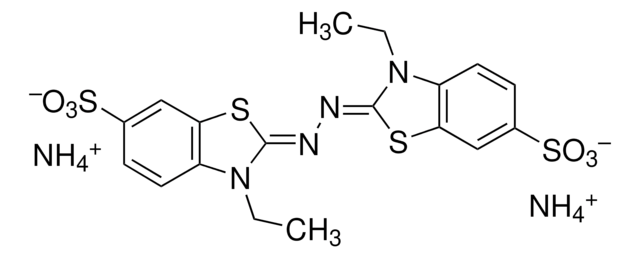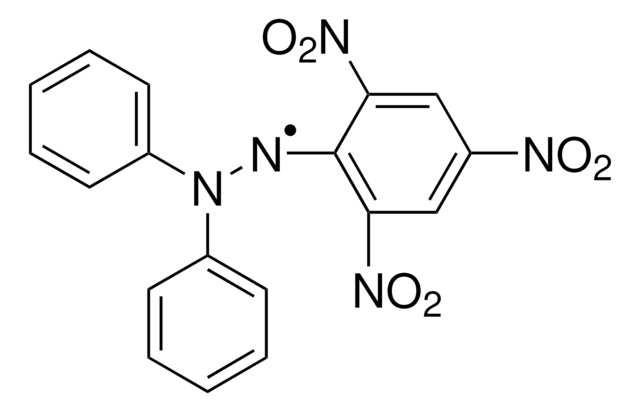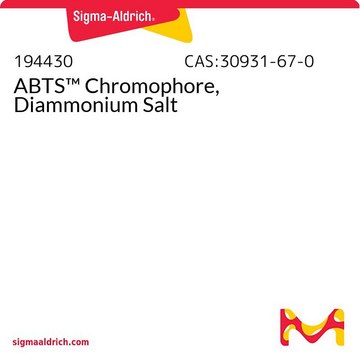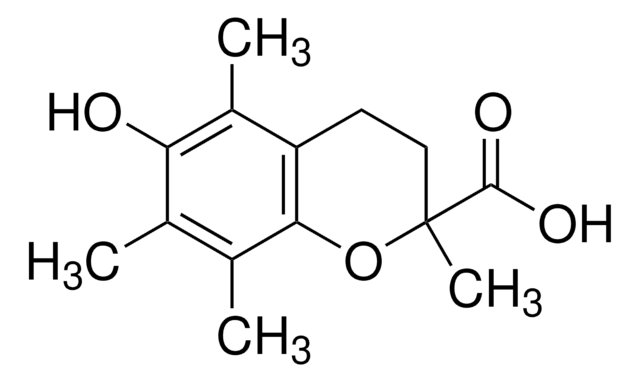A3219
2,2′-Azino-bis(3-ethylbenzothiazoline-6-sulfonic acid)
peroxidase substrate, chromogenic, liquid
Synonym(s):
ABTS
About This Item
Recommended Products
Product Name
2,2′-Azino-bis(3-ethylbenzothiazoline-6-sulfonic acid), Liquid Substrate System
Quality Level
form
liquid
storage temp.
2-8°C
SMILES string
CCN1C(\Sc2cc(ccc12)S(O)(=O)=O)=N\N=C3/Sc4cc(ccc4N3CC)S(O)(=O)=O
InChI
1S/C18H18N4O6S4/c1-3-21-13-7-5-11(31(23,24)25)9-15(13)29-17(21)19-20-18-22(4-2)14-8-6-12(32(26,27)28)10-16(14)30-18/h5-10H,3-4H2,1-2H3,(H,23,24,25)(H,26,27,28)/b19-17-,20-18-
InChI key
ZTOJFFHGPLIVKC-CLFAGFIQSA-N
Looking for similar products? Visit Product Comparison Guide
General description
Application
Biochem/physiol Actions
Physical form
Storage Class Code
10 - Combustible liquids
WGK
WGK 3
Flash Point(F)
Not applicable
Flash Point(C)
Not applicable
Choose from one of the most recent versions:
Already Own This Product?
Find documentation for the products that you have recently purchased in the Document Library.
Which document(s) contains shelf-life or expiration date information for a given product?
If available for a given product, the recommended re-test date or the expiration date can be found on the Certificate of Analysis.
How do I get lot-specific information or a Certificate of Analysis?
The lot specific COA document can be found by entering the lot number above under the "Documents" section.
Should Product A3219, 2,2´-Azino-bis(3-ethylbenzothiazoline-6-sulfonic acid), be diluted prior to use?
No, this product is offered as a ready-to-use (1×) solution.
When using Product A3219, 2,2´-Azino-bis(3-ethylbenzothiazoline-6-sulfonic acid), at what wavelength should the product of the reaction be measured?
The product should be measured at 405 nm. For end point assays, the reaction may be stopped with 1% (w/v) SDS and also read at 405 nm.
What is the concentration of Product A3219, 2,2´-Azino-bis(3-ethylbenzothiazoline-6-sulfonic acid)?
The concentration of the ABTS is approximately 1.8 mM.
How do I find price and availability?
There are several ways to find pricing and availability for our products. Once you log onto our website, you will find the price and availability displayed on the product detail page. You can contact any of our Customer Sales and Service offices to receive a quote. USA customers: 1-800-325-3010 or view local office numbers.
What is the Department of Transportation shipping information for this product?
Transportation information can be found in Section 14 of the product's (M)SDS.To access the shipping information for this material, use the link on the product detail page for the product.
My question is not addressed here, how can I contact Technical Service for assistance?
Ask a Scientist here.
Articles
NBT-BCIP substrate system aids in western blotting and immunohistological staining, producing a blue-purple insoluble end product.
Our team of scientists has experience in all areas of research including Life Science, Material Science, Chemical Synthesis, Chromatography, Analytical and many others.
Contact Technical Service




